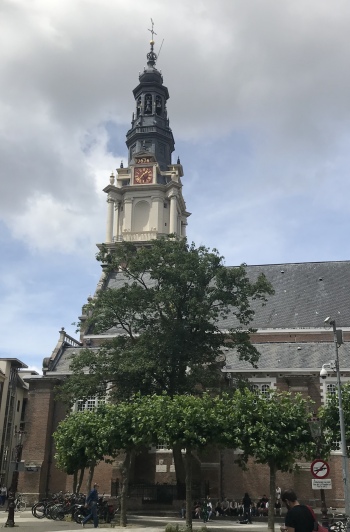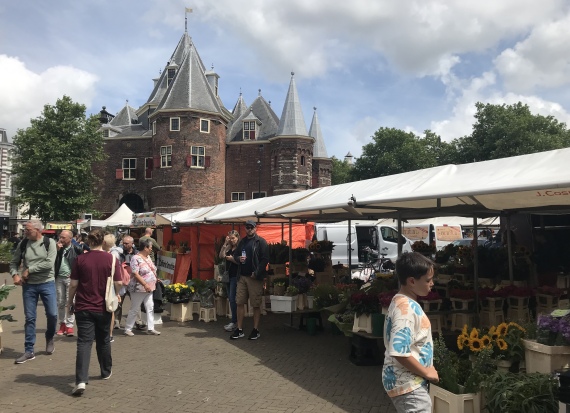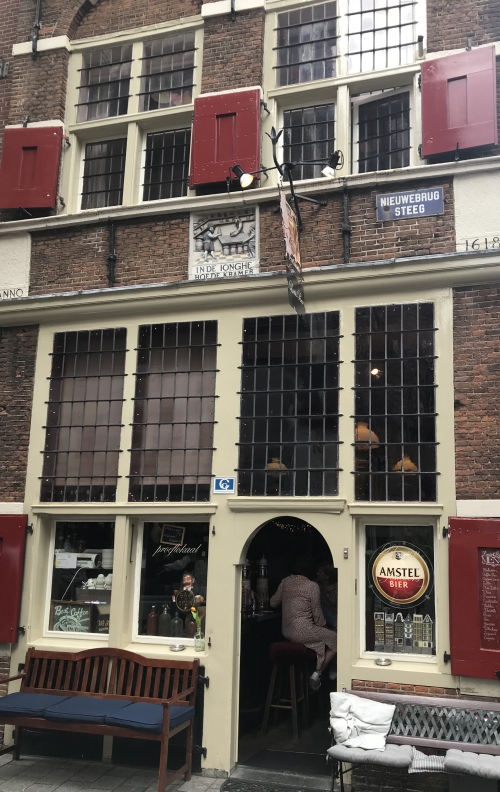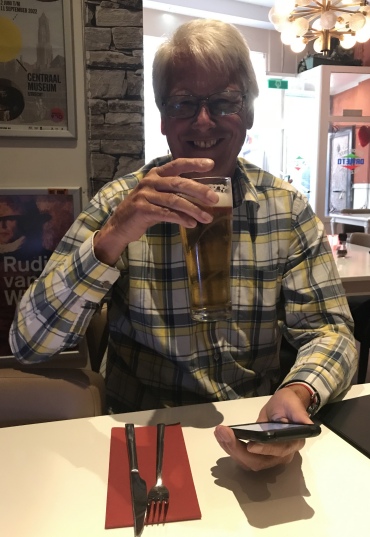 Zuiderkerk |
 Nieuwmarkt |
 In De Jonghe Hof De Kramer |
After a late start in the morning, a little research revealed a landscape photography exhibition in the suburbs that seemed interesting. However, it would have taken over an hour to reach on busses from the Centraal Station, so I dropped the idea. Instead, I headed off to visit the Amsterdam Museum, a place I had visited in 2015 with Rex and Meryl, and later with my son Dan. I tried to visit it earlier this year when I visited Amsterdam with Dan, only to discover it had moved.
Now I knew where it had moved to, I set off to explore it once again. My hike took me past Nieuwmarkt where I browsed for a while around the market stalls, bustling with tourists. Not far away stood the The Zuiderkerk, a 17th-century Protestant church. Soon I was skirting the Amstel, but then my route was impeded by a workman who was striding around the Walter Suskindbrug. He had taped off the bridge since it was experiencing a mechanical hazard. After a detour around the problem, I arrived at where I thought the museum ought to be. Hmmm ...., all I could see was the Hermitage. I enquired and discovered the Amsterdam Museum was being temporally being housed in a section at the back of the Hermitage.
A tiny Chinese lady who spoke impeccable English quickly explained the layout of the temporary museum. The ground floor gave a historical tour of the city, starting in the 15th century, though the city is certainly older than that.
Amsterdam had been the last Catholic stronghold in the country before it caved into Protestantism. Because of its excellent location on the Ijsselmeer, it became the centre of much trade, and soon became the centre of trade for Europe, focussing on timber, beer and textiles. Things moved at a pace when the VOC expanded trade to cover the Dutch East Indies (spice trade). The VOC, Vereenigde Oostindische Compagnie or "United East India Company", was a chartered company established in 1602, when the States General of the Netherlands granted it a 21-year monopoly to carry out trade activities in Asia. It is sometimes considered to have been the first multinational corporation in the world.
 Business Meal |
In those early days, the gentry established orphanages, the men managing the finances and their wives organising and training those in their care. Holland had prided itself as being a liberal country, banning slavery. As for its colonies, however, slavery persisted, and it did not disappear until after Indonesia became independent.
Much emphasis in the museum was placed on women's rights and suffrage, plus the rights of other groups, be they religious, race, gender, use of drugs etc.
The upstairs section of the museum focussed on the present and the future. The north of the city was highlighted, covering the plight of ethnic groups, attempts at integration, the destruction of communities in order to make way for new developments etc.
This small, temporary exhibition was a disappointment to me when I considered what the museum used to offer. Indeed half of it was not related to history at all. Hopefully a happy compromise will be reached when it finally finds a new home for itself.
On the way back to the station, I rediscovered In De Jonghe Hof De Kramer. This had been a delightful 17th century pub that sold only gins. Dan and I had stumbled upon it a few years back, and we even took my brother-in-law, Dick, to it. Dick is a keen gin drinker, but let himself down when he asked for a gin and tonic. The pub went silent when he requested tonic water, tonic water in gin was alien to them. Sadly it is now just a pub.
Rex caught the ferry across to meet me, and we enjoyed a beer at the Café Karpershoek opposite Centraal Station, a classic pub dating back to the 17th century. It was at a busy junction, a great place to observe all manner of life as it made its way from Centraal Station into the city. Folk wore a huge variety of garbs. Hen parties were obvious from the veils they wore. Cars and cyclists whizzed around the corner, with the occasional horn blast and one fingered salutes by cyclists as they narrowly avoided mowing down a pedestrian. We later dined well in this almost Bohemian part of town.
